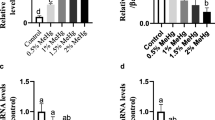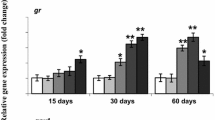Abstract
Manganese (Mn)-containing dithiocarbamates such as Mancozeb (MZ) have been shown to induce oxidative stress-related toxicity in rodents and humans. However, little is known about the neurotoxic effects induced by MZ in fish. In this study, carp (Cyprinus carpio) were exposed to non-lethal waterborne concentrations of MZ, and oxidative stress parameters as well as metal accumulation in fish brains were evaluated. The experimental groups were as follows: control, MZ 5 mg/L, and MZ 10 mg/L. Fish were exposed for 7 days, and then brain was removed and prepared for subsequent analysis of antioxidant enzymes, reactive oxygen species (ROS), and expression of Nrf2 and phosphoNrf2. In parallel, manganese (Mn) levels were evaluated in blood and brain tissues. Mn levels were significantly increased in blood and brain of MZ-exposed carps. In addition, a concentration-dependent increase (p < 0.05) in ROS levels was observed in parallel to increments (p < 0.05) in the activity of major antioxidant enzymes, such as GPx, GR, and GST. On the other hand, significant decreases (p < 0.05) in CAT and SOD activities were observed. The expression of total and phosphorylated forms of Nrf2 was significantly (p < 0.05) upregulated in the brain of carps exposed to Mz when compared to the control, indicating an activation of the Nrf2 antioxidant pathway. Our study showed for the first time the activation of the Nrf2/ARE pathway and bioaccumulation of Mn induced by MZ exposure in fish species, highlighting important mechanisms of action and its toxicological impacts to aquatic organisms.






Similar content being viewed by others
References
Aebi H (1984) Catalase in vitro. Methods Enzymol 105:121–126
Al-Alam J, Bom L, Chbani A et al (2017) Analysis of dithiocarbamate fungicides in vegetable matrices using HPLC-UV followed by atomic absorption spectrometry. J Chromatogr Sci 55:429–435. https://doi.org/10.1093/chromsci/bmw198
Asagba SO, Eriyamremu GE, Igberaese ME (2008) Bioaccumulation of cadmium and its biochemical effect on selected tissues of the catfish. Fish Physiol Biochem 34:61–69. https://doi.org/10.1007/s10695-007-9147-4
Atamaniuk TM, Kubrak OI, Husak VV, Storey KB, Lushchak VI (2014) The Mancozeb-containing carbamate fungicide tattoo induces mild oxidative stress in goldfish brain, liver, and kidney. Environ Toxicol 29:1227–1235. https://doi.org/10.1002/tox.21853
Bisson M, Hontela A (2002) Cytotoxic and endocrine-disrupting potential of atrazine, diazinon, endosulfan, and mancozeb in adrenocortical steroidogenic cells of rainbow trout exposed in vitro. Toxicol Appl Pharmacol 180:110–117. https://doi.org/10.1006/taap.2002.9377
Bloom DA, Jaiswal AK (2003) Phosphorylation of Nrf2 at Ser40 by protein kinase C in response to antioxidants leads to the release of Nrf2 from INrf2, but is not required for Nrf2 stabilization/accumulation in the nucleus and transcriptional activation of antioxidant response element-mediated NAD(P)H:quinone oxidoreductase-1 gene expression. J Biol Chem 278:44675–44682. https://doi.org/10.1074/jbc.M307633200
Calviello G, Piccioni E, Boninsegna A et al (2006) DNA damage and apoptosis induction by the pesticide Mancozeb in rat cells: involvement of the oxidative mechanism. Toxicol Appl Pharmacol 211:87–96. https://doi.org/10.1016/j.taap.2005.06.001
Carlberg I, Mannervik B (1985) Glutathione reductase. Methods Enzymol 113:484–490
Grisolia CK (2005) Agrotóxicos: Mutações. Câncer e Reprodução, Brasília
Chen CT, Green JT, Orr SK, Bazinet RP (2008) Regulation of brain polyunsaturated fatty acid uptake and turnover. Prostaglandins Leukot Essent Fatty Acids 79:85–91. https://doi.org/10.1016/j.plefa.2008.09.003
Chtourou Y, Fetoui H, Sefi M, Trabelsi K, Barkallah M, Boudawara T, Kallel H, Zeghal N (2010) Silymarin, a natural antioxidant, protects cerebral cortex against manganese-induced neurotoxicity in adult rats. Biometals Int J Role MetiIons Biol Biochem Med 23:985–996. https://doi.org/10.1007/s10534-010-9345-x
Coronado GD, Thompson B, Strong L, Griffith WC, Islas I (2004) Agricultural task and exposure to organophosphate pesticides among farmworkers. Environ Health Perspect 112:142–147
Costa-Silva DG, Nunes MEM, Wallau GL, Martins IK, Zemolin APP, Cruz LC, Rodrigues NR, Lopes AR, Posser T, Franco JL (2015) Oxidative stress markers in fish (Astyanax sp. and Danio rerio) exposed to urban and agricultural effluents in the Brazilian Pampa biome. Environ Sci Pollut Res Int 22:15526–15535. https://doi.org/10.1007/s11356-015-4737-7
Dolci GS, Vey LT, Schuster AJ, Roversi K, Roversi K, Dias VT, Pase CS, Barcelos RCS, Antoniazzi CTD, Golombieski JI, Glanzner WG, Anezi Junior PA, Gonçalves PBD, Nunes MAG, Dressler VL, Baldisserotto B, Burger ME (2014) Hypoxia acclimation protects against oxidative damage and changes in prolactin and somatolactin expression in silver catfish (Rhamdia quelen) exposed to manganese. Aquat Toxicol 157:175–185. https://doi.org/10.1016/j.aquatox.2014.10.015
Easton A, Guven K, de Pomerai DI (2001) Toxicity of the dithiocarbamate fungicide mancozeb to the nontarget soil nematode, Caenorhabditis elegans. J Biochem Mol Toxicol 15:15–25
Fitsanakis VA, Amarnath V, Moore JT, et al (2002) Catalysis of catechol oxidation by metaldithiocarbamate complexes in pesticides. Free Radic Biol Med 33:1714–1723
Fuentes-Rios D, Orrego R, Rudolph A, Mendoza G, Gavilán JF, Barra R (2005) EROD activity and biliary fluorescence in Schroederichthys chilensis (Guichenot 1848): biomarkers of PAH exposure in coastal environments of the South Pacific Ocean. Chemosphere 61:192–199. https://doi.org/10.1016/j.chemosphere.2005.02.062
Gabriel D, Riffel APK, Finamor IA, Saccol EMH, Ourique GM, Goulart LO, Kochhann D, Cunha MA, Garcia LO, Pavanato MA, Val AL, Baldisserotto B, Llesuy SF (2013) Effects of subchronic manganese chloride exposure on tambaqui (Colossoma macropomum) tissues: oxidative stress and antioxidant defenses. Arch Environ Contam Toxicol 64:659–667. https://doi.org/10.1007/s00244-012-9854-4
Garcinuño RM, Ramos L, Fernández-Hernando P, Cámara C (2004) Optimization of a matrix solid-phase dispersion method with subsequent clean-up for the determination of ethylene bisdithiocarbamate residues in almond samples. J Chromatogr A 1041:35–41
Geissen V, Ramos FQ, de J. Bastidas-Bastidas P, Díaz-González G, Bello-Mendoza R, Huerta-Lwanga E, Ruiz-Suárez LE (2010) Soil and water pollution in a banana production region in tropical Mexico. Bull Environ Contam Toxicol 85:407–413. https://doi.org/10.1007/s00128-010-0077-y
Glisic B, Mihaljevic I, Popovic M, et al (2015) Characterization of glutathione-S-transferases in zebrafish (Danio rerio). Aquat Toxicol Amst Neth 158:50–62. https://doi.org/10.1016/j.aquatox.2014.10.013
Goldoni A, da Silva LB (2012) Mutagenic potential of the fungicide mancozeb in astyanax jacuhiensis (Teleostei: Characidae). ResearchGate 28:297–301
Gustafsson KH, Thompson RA (1981) High-pressure liquid chromatographic determination of fungicidal dithiocarbamates. J Agric Food Chem 29:729–732
Habig WH, Jakoby WB (1981) Assays for differentiation of glutathione S-transferases. Methods Enzymol 77:398–405
Halliwell B (2006) Reactive species and antioxidants. Redox biology is a fundamental theme of aerobic life. Plant Physiol 141:312–322. https://doi.org/10.1104/pp.106.077073
Harrison Brody A, Chou E, Gray JM, Pokyrwka NJ, Raley-Susman KM (2013) Mancozeb-induced behavioral deficits precede structural neural degeneration. Neurotoxicology 34:74–81. https://doi.org/10.1016/j.neuro.2012.10.007
Hayes JD, Flanagan JU, Jowsey IR (2005) Glutathione transferases. Annu Rev Pharmacol Toxicol 45:51–88. https://doi.org/10.1146/annurev.pharmtox.45.120403.095857
Hoffman L, Hardej D (2012) Ethylene bisdithiocarbamate pesticides cause cytotoxicity in transformed and normal human colon cells. Environ Toxicol Pharmacol 34:556–573. https://doi.org/10.1016/j.etap.2012.06.015
Hogarth G (2012) Metal-dithiocarbamate complexes: chemistry and biological activity. Mini Rev Med Chem 12:1202–1215
Holmgren A, Björnstedt M (1995) Thioredoxin and thioredoxin reductase. Methods Enzymol 252:199–208
Houeto P, Bindoula G, Hoffman JR (1995) Ethylenebisdithiocarbamates and ethylenethiourea: possible human health hazards. Environ Health Perspect 103:568–573
Jarrard HE, Delaney KR, Kennedy CJ (2004) Impacts of carbamate pesticides on olfactory neurophysiology and cholinesterase activity in coho salmon (Oncorhynchus kisutch). Aquat Toxicol Amst Neth 69:133–148. https://doi.org/10.1016/j.aquatox.2004.05.001
Jena BS, Nayak SB, Patnaik BK (1998) Age-related changes in catalase activity and its inhibition by manganese (II) chloride in the brain of two species of poikilothermic vertebrates. Arch Gerontol Geriatr 26:119–129
Keppler D (1999) Export pumps for glutathione S-conjugates. Free Radic Biol Med 27:985–991
Kostyuk VA, Potapovich AI (1989) Superoxide-driven oxidation of quercetin and a simple sensitive assay for determination of superoxide dismutase. Biochem Int 19:1117–1124
Kubrak OI, Atamaniuk TM, Husak VV, Drohomyretska IZ, Storey JM, Storey KB, Lushchak VI (2012) Oxidative stress responses in blood and gills of Carassius auratus exposed to the mancozeb-containing carbamate fungicide tattoo. Ecotoxicol Environ Saf 85:37–43. https://doi.org/10.1016/j.ecoenv.2012.08.021
Kontou S, Tsipi D, Oreopoulou V, Tzia C (2001) Determination of ETU in tomatoes and tomato products by HPLC-PDA: evaluation of cleanup procedures. J Agric Food Chem 49:1090–1097
Larsson KS, Arnander C, Cekanova E, Kjellberg M (1976) Studies of teratogenic effects of the dithiocarbamates maneb, mancozeb, and propineb. Teratology 14:171–183. https://doi.org/10.1002/tera.1420140208
López-Fernández O, Pose-Juan E, Rial-Otero R, Simal-Gándara J (2017) Effects of hydrochemistry variables on the half-life of mancozeb and on the hazard index associated to the sum of mancozeb and ethylenethiourea. Environ Res 154:253–260. https://doi.org/10.1016/j.envres.2017.01.016
Marques A, Rego A, Guilherme S, Gaivão I, Santos MA, Pacheco M (2016) Evidences of DNA and chromosomal damage induced by the mancozeb-based fungicide Mancozan(®) in fish (Anguilla anguilla L.) Pestic Biochem Physiol 133:52–58. https://doi.org/10.1016/j.pestbp.2016.03.004
Nguyen T, Nioi P, Pickett CB (2009) The Nrf2-antioxidant response element signaling pathway and its activation by oxidative stress. J Biol Chem 284:13291–13295. https://doi.org/10.1074/jbc.R900010200
Nunes ME, Müller TE, Braga MM, et al (2017) Chronic Treatment with Paraquat Induces Brain Injury, Changes in Antioxidant Defenses System, and Modulates Behavioral Functions in Zebrafish. Mol Neurobiol 54:3925–3934. https://doi.org/10.1007/s12035-016-9919-x
O’Brien J, Wilson I, Orton T, Pognan F (2000) Investigation of the Alamar Blue (resazurin) fluorescent dye for the assessment of mammalian cell cytotoxicity. Eur J Biochem 267:5421–5426
Ohkawa H, Ohishi N, Yagi K (1979) Assay for lipid peroxides in animal tissues by thiobarbituric acid reaction. Anal Biochem 95:351–358
Pérez-Severiano F, Rodríguez-Pérez M, Pedraza-Chaverrí J, Maldonado PD, Medina-Campos ON, Ortíz-Plata A, Sánchez-García A, Villeda-Hernández J, Galván-Arzate S, Aguilera P, Santamaría A (2004) S-Allylcysteine, a garlic-derived antioxidant, ameliorates quinolinic acid-induced neurotoxicity and oxidative damage in rats. Neurochem Int 45:1175–1183. https://doi.org/10.1016/j.neuint.2004.06.008
Rath NC, Rasaputra KS, Liyanage R, et al (2011) Dithiocarbamate toxicity—an appraisal. Pestic Mod World-Eff Pestic Expo Ed M Stoytcheva InTech Publ Online N Y 323–340
Rodriguez C, Mayo JC, Sainz RM, Antolin I, Herrera F, Martin V, Reiter RJ (2004) Regulation of antioxidant enzymes: a significant role for melatonin. J Pineal Res 36:1–9
Schülke S, Dreidax D, Malik A, Burmester T, Nevo E, Band M, Avivi A, Hankeln T (2012) Living with stress: regulation of antioxidant defense genes in the subterranean, hypoxia-tolerant mole rat, Spalax. Gene 500:199–206. https://doi.org/10.1016/j.gene.2012.03.019
Singh DA, Srivastava DP (2013) In-vivo study of effects of dithiocarbamates fungicide (Mancozeb) and its metabolite ethylenethiourea (ETU) on fresh water fish Clarius batrachus. J Biol Earth Sci 3:228–235
Steffens W, Wirth M (2004) Freshwater fish - An important source of n-3 polyunsaturated fatty acids: a review
Storey KB (1996) Oxidative stress: animal adaptations in nature. Braz J Med Biol Res Rev ras Pesqui Medicas E Biol 29:1715–1733
Tanito M, Agbaga M-P, Anderson RE (2007) Upregulation of thioredoxin system via Nrf2-antioxidant responsive element pathway in adaptive-retinal neuroprotection in vivo and in vitro. Free Radic Biol Med 42:1838–1850. https://doi.org/10.1016/j.freeradbiomed.2007.03.018
U.S. EPA. Supplemental Guidance for Assessing Susceptibility from Early-Life Exposure to Carcinogens. U.S. Environmental Protection Agency, Washington, DC, EPA/630/R-03/003F, 2005
Valentine HL, Amarnath K, Amarnath V, Valentine WM (2006) Dietary copper enhances the peripheral myelinopathy produced by oral pyrrolidine dithiocarbamate. Toxicol Sci Off J Soc Toxicol 89:485–494. https://doi.org/10.1093/toxsci/kfj047
Vieira MC, Torronteras R, Córdoba F, Canalejo A (2012) Acute toxicity of manganese in goldfish Carassius auratus is associated with oxidative stress and organ specific antioxidant responses. Ecotoxicol Environ Saf 78:212–217. https://doi.org/10.1016/j.ecoenv.2011.11.015
Wendel A (1981) Glutathione peroxidase. Methods Enzymol 77:325–333
Williams C-A, Lin Y, Maynard A, Cheng S-Y (2013) Involvement of NF kappa B in potentiated effect of Mn-containing dithiocarbamates on MPP(+) induced cell death. Cell Mol Neurobiol 33:815–823. https://doi.org/10.1007/s10571-013-9948-1
Zizza M, Di Lorenzo M, Laforgia V et al (2017) HSP90 and pCREB alterations are linked to mancozeb-dependent behavioral and neurodegenerative effects in a marine teleost. Toxicol Appl Pharmacol 323:26–35. https://doi.org/10.1016/j.taap.2017.03.018
Xu S (2000) Environmental fate of ethylenethiourea. Department of Pesticide Regulation, Sacramento 10 p. http:// www.cdpr.ca.gov/docs/emon/pubs/fatememo/etu.pdf. Accessed 4 Jul 2017
Funding
The authors received financial support from the Brazilian agencies CNPq (310861/2014-4) and FAPERGS (16/2551-0000499-4).
Author information
Authors and Affiliations
Corresponding author
Ethics declarations
Animal experimentation in this study fully adhered to the National Institute of Health Guide for Care and Use of Laboratory and the protocols were approved by the Ethics Commission on Animal Use of the Federal University of Pampa under process number 043/2013.
Conflict of interest
The authors declare that they have no conflict of interest.
Additional information
Responsible editor: Markus Hecker
Rights and permissions
About this article
Cite this article
Costa-Silva, D.G., Lopes, A.R., Martins, I.K. et al. Mancozeb exposure results in manganese accumulation and Nrf2-related antioxidant responses in the brain of common carp Cyprinus carpio. Environ Sci Pollut Res 25, 15529–15540 (2018). https://doi.org/10.1007/s11356-018-1724-9
Received:
Accepted:
Published:
Issue Date:
DOI: https://doi.org/10.1007/s11356-018-1724-9




